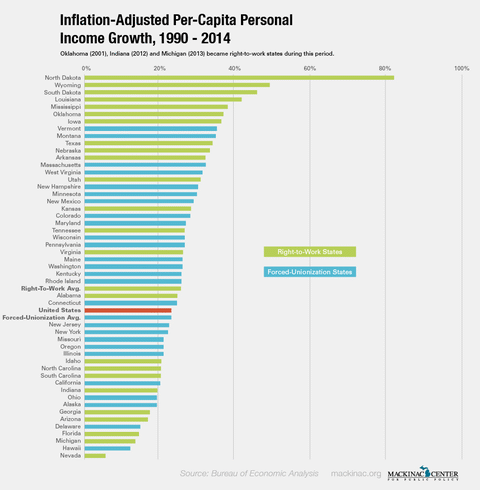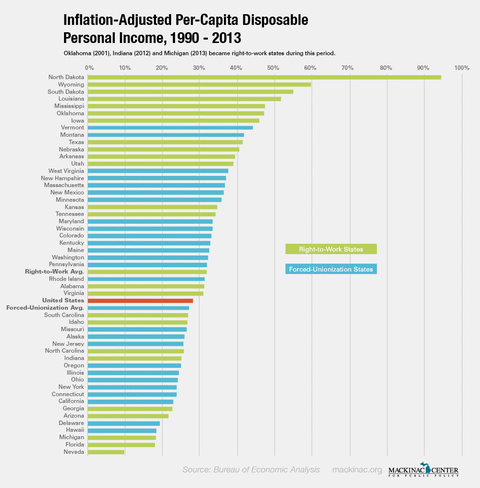Commentary
RTW States Lead the Way
More income, population growth
During the debate in Michigan over right-to-work, critics commonly incited fear that it would result in lower incomes for Michigan workers.
For example, President Obama claimed in 2012 that the law meant "giving you the right to work for less money."
As right-to-work is being discussed in other states, including Missouri, the fears about its impact on income are reiterated. The Committee to Protect Missouri Families, a coalition fighting right-to-work legislation, claims on its website that the law "cuts wages and stifles job growth by reducing people's discretionary income. When people have less discretionary income, they spend less, which in turn, hurts the economy."
The evidence, however, contradicts these claims. According to data from the Bureau of Economic Analysis, inflation-adjusted per capita personal income growth in right-to-work states is higher than in non-right-to-work states. Between 1990 and 2013, inflation-adjusted per-capita personal income in all right-to-work states grew by 30.7 percent compared to 27.5 percent in all forced unionization states.
In fact, of the 10 states with fastest inflation-adjusted per-capita personal income growth during that time, seven were right-to-work and one, Oklahoma, became right-to-work about halfway through the period.

The advantage right-to-work states have in income growth becomes more apparent when the components of per-capita income growth are considered. Right-to-work states have enjoyed even more considerable advantages in both population and gross personal income growth. Population in right-to-work states grew by 42.7 percent between 1990 and 2013 as opposed to 18.7 percent for forced unionization states. For inflation-adjusted gross personal income, right-to-work states gained 86.5 percent between 1990 and 2013 versus 51.3 percent for forced unionization states.
When it comes to disposable income — the income workers receive after state, federal and local taxes — right-to-work states also dominate. According to the BEA, inflation-adjusted per-capita disposable personal income growth between 1990 and 2013 in right-to-work states was 31.8 percent as opposed to 27.2 percent in forced unionization states. Seven of the 10 states with the fastest growth between 1990 and 2013 in inflation-adjusted per-capita disposable personal income were right-to-work states, (again including Oklahoma, which became a right-to-work state halfway through the period).

As previous analysis by the Mackinac Center has shown, right-to-work states tend to have higher growth in median household income and employment as well.
A 2013 study by Michael J. Hicks, a member of the Mackinac Center’s board of scholars and a professor at Ball State University, and Michael LaFaive, director of the Morey Fiscal Policy Initiative at the Center, analyzed the impact of right-to-work legislation on real incomes between 1947 and 2011. The study used an econometric model designed to overcome timing difficulties, economic variables and policies unrelated to right to work, and other research difficulties by dividing the data into four time periods. LaFaive and Hicks found that right-to-work laws boosted average annual real personal income growth by 0.75 percent between 1947 and 2011 compared to the growth states would have experienced without right-to-work laws.
Many factors influence the growth of income in these states besides right-to-work and the data does not mean right-to-work alone causes income to grow faster. The predicted decline in income made by opponents, however, is tough to find. Right-to-work states have some of the fastest growing incomes in the country over the past few decades.
|

RTW States Lead the Way
More income, population growth
During the debate in Michigan over right-to-work, critics commonly incited fear that it would result in lower incomes for Michigan workers.
For example, President Obama claimed in 2012 that the law meant "giving you the right to work for less money."
As right-to-work is being discussed in other states, including Missouri, the fears about its impact on income are reiterated. The Committee to Protect Missouri Families, a coalition fighting right-to-work legislation, claims on its website that the law "cuts wages and stifles job growth by reducing people's discretionary income. When people have less discretionary income, they spend less, which in turn, hurts the economy."
The evidence, however, contradicts these claims. According to data from the Bureau of Economic Analysis, inflation-adjusted per capita personal income growth in right-to-work states is higher than in non-right-to-work states. Between 1990 and 2013, inflation-adjusted per-capita personal income in all right-to-work states grew by 30.7 percent compared to 27.5 percent in all forced unionization states.
In fact, of the 10 states with fastest inflation-adjusted per-capita personal income growth during that time, seven were right-to-work and one, Oklahoma, became right-to-work about halfway through the period.
The advantage right-to-work states have in income growth becomes more apparent when the components of per-capita income growth are considered. Right-to-work states have enjoyed even more considerable advantages in both population and gross personal income growth. Population in right-to-work states grew by 42.7 percent between 1990 and 2013 as opposed to 18.7 percent for forced unionization states. For inflation-adjusted gross personal income, right-to-work states gained 86.5 percent between 1990 and 2013 versus 51.3 percent for forced unionization states.
When it comes to disposable income — the income workers receive after state, federal and local taxes — right-to-work states also dominate. According to the BEA, inflation-adjusted per-capita disposable personal income growth between 1990 and 2013 in right-to-work states was 31.8 percent as opposed to 27.2 percent in forced unionization states. Seven of the 10 states with the fastest growth between 1990 and 2013 in inflation-adjusted per-capita disposable personal income were right-to-work states, (again including Oklahoma, which became a right-to-work state halfway through the period).
As previous analysis by the Mackinac Center has shown, right-to-work states tend to have higher growth in median household income and employment as well.
A 2013 study by Michael J. Hicks, a member of the Mackinac Center’s board of scholars and a professor at Ball State University, and Michael LaFaive, director of the Morey Fiscal Policy Initiative at the Center, analyzed the impact of right-to-work legislation on real incomes between 1947 and 2011. The study used an econometric model designed to overcome timing difficulties, economic variables and policies unrelated to right to work, and other research difficulties by dividing the data into four time periods. LaFaive and Hicks found that right-to-work laws boosted average annual real personal income growth by 0.75 percent between 1947 and 2011 compared to the growth states would have experienced without right-to-work laws.
Many factors influence the growth of income in these states besides right-to-work and the data does not mean right-to-work alone causes income to grow faster. The predicted decline in income made by opponents, however, is tough to find. Right-to-work states have some of the fastest growing incomes in the country over the past few decades.
Michigan Capitol Confidential is the news source produced by the Mackinac Center for Public Policy. Michigan Capitol Confidential reports with a free-market news perspective.
More From CapCon